Comprehensive Computational Model for Coupled Fluid Flow, Mass Transfer, and Light Supply in Tubular Photobioreactors Equipped with Glass Sponges
Abstract
1. Introduction
- We propose a coupled, comprehensive, spatially three-dimensional simulation model for light supply, flow pattern, and mass transfer based on LBM.
- We implemented the model in the open-source parallel C++ framework OpenLB.
- We showcase the coupled simulation results for PBR with internal glass sponges.
- We assessed the individual model results quantitatively via comparison to experiments.
- We discuss the simulation results with respect to other simulation approaches [4].
2. Materials & Methods
2.1. Description of the Glass Sponge PBR
- (i)
- The so-called light dilution is achieved by increasing the illumination area by the surface area of the sponges in addition to the surface area of the PBR itself. The sponges conduct light to deeper positions (Figure 2) in the PBR and also decrease the light path in the microalgal culture.
- (ii)
- Algae grow within the pores of the sponges and become illuminated from all directions due to the multiple and complex reflections in the glass sponges. The illumination from all directions toward the center of each pore focuses the light, as shown in Figure 3. This focus effect counteracts the attenuation of light due to the scattering and absorption of algae along the light path.
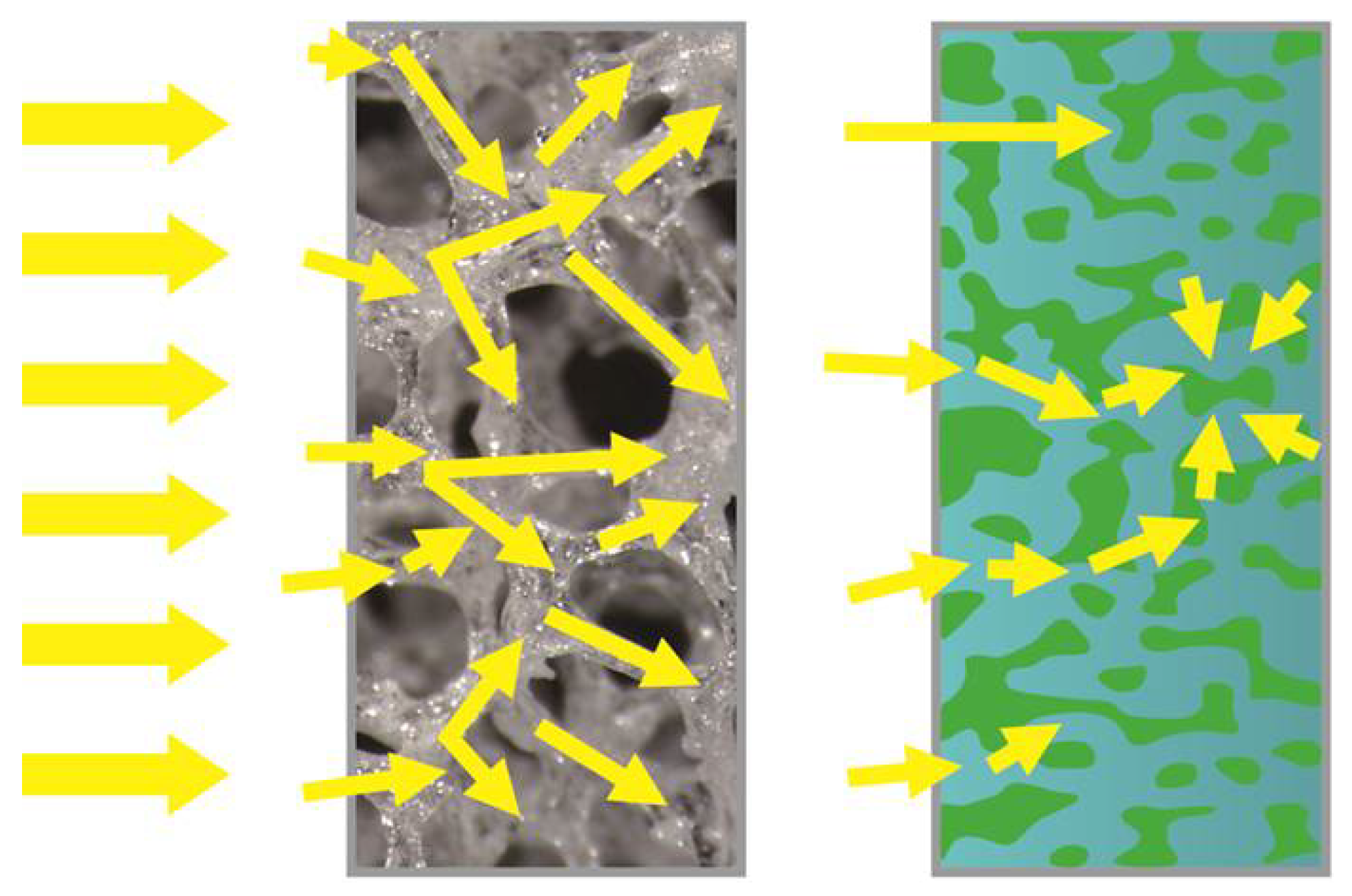

2.2. Mesoscopic Modeling and the Lattice Boltzmann Method
2.3. Light Distribution Model
2.4. Fluid Flow Regime and Lagrangian Particles
2.5. Mass Transport
2.6. Algae Growth Model and Coupling
3. Results
3.1. Geometry and Computational Parameters
3.2. Simulation Sequence
3.3. Validation of Light Simulation
3.4. Light Simulation of Complex Geometry
- (i)
- The sponges and the tubular surface emit light at equal intensities.
- (ii)
- The same amount of photons per time as in (i) is emitted by the PBR surface only.

3.5. Fluid Flow Regime and Gaseous Transport
3.6. Biomass Growth
4. Discussion
5. Conclusions
Author Contributions
Funding
Data Availability Statement
Acknowledgments
Conflicts of Interest
References
- Cornet, J.F. Calculation of optimal design and ideal productivities of volumetrically lightened photobioreactors using the constructal approach. Chem. Eng. Sci. 2010, 65, 985–998. [Google Scholar] [CrossRef]
- Jacobi, A.; Bucharsky, E.C.; Schell, K.G.; Habisreuther, P.; Oberacker, R.; Hoffmann, M.J.; Zarzalis, N.; Posten, C. The Application of Transparent Glass Sponge for Improvement of Light Distribution in Photobioreactors. J. Bioprocess. Biotech. 2012, 2. [Google Scholar] [CrossRef]
- Nwoba, E.G.; Parlevliet, D.A.; Laird, D.W.; Alameh, K.; Moheimani, N.R. Light management technologies for increasing algal photobioreactor efficiency. Algal Res. 2019, 39, 101433. [Google Scholar] [CrossRef]
- Luzi, G.; McHardy, C. Modeling and Simulation of Photobioreactors with Computational Fluid Dynamics—A Comprehensive Review. Energies 2022, 15, 3966. [Google Scholar] [CrossRef]
- Gómez-Pérez, C.; Espinosa, J.; Ruiz, L.M.; van Boxtel, A. CFD simulation for reduced energy costs in tubular photobioreactors using wall turbulence promoters. Algal Res. 2015, 12, 1–9. [Google Scholar] [CrossRef]
- Huang, J.; Feng, F.; Wan, M.; Ying, J.; Li, Y.; Qu, X.; Pan, R.; Shen, G.; Li, W. Improving performance of flat-plate photobioreactors by installation of novel internal mixers optimized with computational fluid dynamics. Bioresour. Technol. 2015, 182, 151–159. [Google Scholar] [CrossRef] [PubMed]
- Gao, X.; Kong, B.; Vigil, R.D. CFD investigation of bubble effects on Taylor–Couette flow patterns in the weakly turbulent vortex regime. Chem. Eng. J. 2015, 270, 508–518. [Google Scholar] [CrossRef]
- Kong, B.; Vigil, R.D. Simulation of photosynthetically active radiation distribution in algal photobioreactors using a multidimensional spectral radiation model. Bioresour. Technol. 2014, 158, 141–148. [Google Scholar] [CrossRef]
- Csogör, Z.; Herrenbauer, M.; Schmidt, K.; Posten, C. Light distribution in a novel photobioreactor—Modelling for optimization. J. Appl. Phycol. 2001, 13, 325–333. [Google Scholar] [CrossRef]
- Dauchet, J.; Blanco, S.; Cornet, J.F.; Hafi, M.E.; Eymet, V.; Fournier, R. The practice of recent radiative transfer Monte Carlo advances and its contribution to the field of microorganisms cultivation in photobioreactors. J. Quant. Spectrosc. Radiat. Transf. 2013, 128, 52–59. [Google Scholar] [CrossRef]
- Huang, Q.; Liu, T.; Yang, J.; Yao, L.; Gao, L. Evaluation of radiative transfer using the finite volume method in cylindrical photoreactors. Chem. Eng. Sci. 2011, 66, 3930–3940. [Google Scholar] [CrossRef]
- Perner-Nochta, I.; Posten, C. Simulations of light intensity variation in photobioreactors. J. Biotechnol. 2007, 131, 276–285. [Google Scholar] [CrossRef] [PubMed]
- Lapin, A.; Müller, D.; Reuss, M. Dynamic Behavior of Microbial Populations in Stirred Bioreactors Simulated with Euler–Lagrange Methods: Traveling along the Lifelines of Single Cells. Ind. Eng. Chem. Res. 2004, 43, 4647–4656. [Google Scholar] [CrossRef]
- Gao, X.; Kong, B.; Vigil, R.D. Comprehensive computational model for combining fluid hydrodynamics, light transport and biomass growth in a Taylor vortex algal photobioreactor: Lagrangian approach. Bioresour. Technol. 2017, 224, 523–530. [Google Scholar] [CrossRef] [PubMed]
- Cornet, J.F.; Dussap, C.G. A simple and reliable formula for assessment of maximum volumetric productivities in photobioreactors. Biotechnol. Prog. 2009, 25, 424–435. [Google Scholar] [CrossRef]
- Mink, A.; Thäter, G.; Nirschl, H.; Krause, M.J. A 3D Lattice Boltzmann method for light simulation in participating media. J. Comput. Sci. 2016, 17, 431–437. [Google Scholar] [CrossRef]
- Mink, A.; McHardy, C.; Bressel, L.; Rauh, C.; Krause, M.J. Radiative transfer lattice Boltzmann methods: 3D models and their performance in different regimes of radiative transfer. J. Quant. Spectrosc. Radiat. Transf. 2020, 243, 106810. [Google Scholar] [CrossRef]
- Mink, A.; Schediwy, K.; Haussmann, M.; Posten, C.; Nirschl, H.; Krause, M.J. Fresnel reflection boundary for radiative transport lattice Boltzmann methods in highly scattering volume. arXiv 2021, arXiv:2107.09411. [Google Scholar] [CrossRef]
- Nathen, P.; Gaudlitz, D.; Krause, M.; Kratzke, J. An extension of the Lattice Boltzmann Method for simulating turbulent flows around rotating geometries of arbitrary shape. In Proceedings of the 21st AIAA Computational Fluid Dynamics Conference, San Diego, CA, USA, 24–27 June 2013. [Google Scholar]
- Trunk, R.; Henn, T.; Dörfler, W.; Nirschl, H.; Krause, M.J. Inertial dilute particulate fluid flow simulations with an Euler–Euler lattice Boltzmann method. J. Comput. Sci. 2016, 17, 438–445. [Google Scholar] [CrossRef]
- Maier, M.L.; Henn, T.; Thäter, G.; Nirschl, H.; Krause, M.J. Multiscale Simulation with a Two-Way Coupled Lattice Boltzmann Method and Discrete Element Method. Chem. Eng. Technol. 2017, 40, 1591–1598. [Google Scholar] [CrossRef]
- Gaedtke, M.; Hoffmann, T.; Reinhardt, V.; Thäter, G.; Nirschl, H.; Krause, M. Flow and heat transfer simulation with a thermal large eddy lattice Boltzmann method in an annular gap with an inner rotating cylinder. Int. J. Mod. Phys. C 2019, 30, 1950013. [Google Scholar] [CrossRef]
- Haussmann, M.; Simonis, S.; Nirschl, H.; Krause, M.J. Direct numerical simulation of decaying homogeneous isotropic turbulence–numerical experiments on stability, consistency and accuracy of distinct lattice Boltzmann methods. Int. J. Mod. Phys. C 2019, 30, 1–29. [Google Scholar] [CrossRef]
- Simonis, S.; Frank, M.; Krause, M.J. On relaxation systems and their relation to discrete velocity Boltzmann models for scalar advection–diffusion equations. Philos. Trans. R. Soc. Lond. Ser. A Math. Phys. Eng. Sci. 2020, 378, 20190400. [Google Scholar] [CrossRef] [PubMed]
- Dapelo, D.; Simonis, S.; Krause, M.J.; Bridgeman, J. Lattice-Boltzmann coupled models for advection–diffusion flow on a wide range of Péclet numbers. J. Comput. Sci. 2021, 51, 101363. [Google Scholar] [CrossRef]
- Haussmann, M.; Reinshaus, P.; Simonis, S.; Nirschl, H.; Krause, M.J. Fluid–Structure Interaction Simulation of a Coriolis Mass Flowmeter Using a Lattice Boltzmann Method. Fluids 2021, 6, 167. [Google Scholar] [CrossRef]
- Simonis, S.; Haussmann, M.; Kronberg, L.; Dörfler, W.; Krause, M.J. Linear and brute force stability of orthogonal moment multiple-relaxation-time lattice Boltzmann methods applied to homogeneous isotropic turbulence. Philos. Trans. R. Soc. Lond. Ser. A Math. Phys. Eng. Sci. 2021, 379, 20200405. [Google Scholar] [CrossRef]
- Siodlaczek, M.; Gaedtke, M.; Simonis, S.; Schweiker, M.; Homma, N.; Krause, M.J. Numerical evaluation of thermal comfort using a large eddy lattice Boltzmann method. Build. Environ. 2021, 192, 107618. [Google Scholar] [CrossRef]
- Bukreev, F.; Simonis, S.; Kummerländer, A.; Jeßberger, J.; Krause, M.J. Consistent lattice Boltzmann methods for the volume averaged Navier–Stokes equations. arXiv 2022, arXiv:2208.09267. [Google Scholar] [CrossRef]
- Simonis, S.; Frank, M.; Krause, M.J. Constructing relaxation systems for lattice Boltzmann methods. arXiv 2022, arXiv:2208.14976. [Google Scholar] [CrossRef]
- Simonis, S.; Krause, M.J. Forschungsnahe Lehre unter Pandemiebedingungen. Mitteilungen Dtsch. Math.-Ver. 2022, 30, 43–45. [Google Scholar] [CrossRef]
- Simonis, S.; Krause, M.J. Limit Consistency for Lattice Boltzmann Equations. arXiv 2022, arXiv:2208.06867. [Google Scholar] [CrossRef]
- Simonis, S.; Nguyen, J.; Avis, S.J.; Dörfler, W.; Krause, M.J. Binary mixture flow with free energy lattice Boltzmann methods. PAMM 2022, 22, e202200025. [Google Scholar] [CrossRef]
- Simonis, S.; Oberle, D.; Gaedtke, M.; Jenny, P.; Krause, M.J. Temporal large eddy simulation with lattice Boltzmann methods. J. Comput. Phys. 2022, 454, 110991. [Google Scholar] [CrossRef]
- Krause, M.J.; Kummerländer, A.; Avis, S.J.; Kusumaatmaja, H.; Dapelo, D.; Klemens, F.; Gaedtke, M.; Hafen, N.; Mink, A.; Trunk, R.; et al. OpenLB—Open source lattice Boltzmann code. Comput. Math. Appl. 2021, 81, 258–288. [Google Scholar] [CrossRef]
- Krause, M.; Mink, A.; Trunk, R.; Klemens, F.; Maier, M.L.; Mohrhard, M.; Claro Barreto, A.; Haußmann, M.; Gaedtke, M.; Ross-Jones, J. OpenLB Release 1.2: Open Source Lattice Boltzmann Code. 2018. Available online: https://www.openlb.net/wp-content/uploads/2018/02/olb-1.2r0.tgz (accessed on 17 October 2022). [CrossRef]
- Cercignani, C. The Boltzmann Equation and Its Applications; Applied Mathematical Sciences; Springer: New York, NY, USA, 1987. [Google Scholar]
- Babovsky, H. Die Boltzmann-Gleichung: Modellbildung–Numerik–Anwendungen; Leitfäden der angewandten Mathematik und Mechanik; Vieweg+Teubner Verlag: Wiesbaden, Germany, 2013. [Google Scholar]
- Aidun, C.K.; Clausen, J.R. Lattice-Boltzmann method for complex flows. Annu. Rev. Fluid Mech. 2010, 42, 439–472. [Google Scholar] [CrossRef]
- Krüger, T.; Kusumaatmaja, H.; Kuzmin, A.; Shardt, O.; Silva, G.; Viggen, E.M. The Lattice Boltzmann Method; Springer: Cham, Switzerland, 2017. [Google Scholar]
- Modest, M.F. Radiative Heat Transfer; Academic Press: Cambridge, MA, USA, 2013. [Google Scholar]
- Chandrasekhar, S. Radiative Transfer; Clarendon Press: Oxford, UK, 1950; reprinted by Dover Publications, 1960. [Google Scholar]
- Huang, Q.; Yao, L.; Liu, T.; Yang, J. Simulation of the light evolution in an annular photobioreactor for the cultivation of Porphyridium cruentum. Chem. Eng. Sci. 2012, 84, 718–726. [Google Scholar] [CrossRef]
- McHardy, C.; Horneber, T.; Rauh, C. Spectral simulation of light propagation in participating media by using a lattice Boltzmann method for photons. Appl. Math. Comput. 2018, 319, 59–70. [Google Scholar] [CrossRef]
- Berberoglu, H.; Gomez, P.S.; Pilon, L. Radiation characteristics of Botryococcus braunii, Chlorococcum littorale, and Chlorella sp. used for fixation and biofuel production. J. Quant. Spectrosc. Radiat. Transf. 2009, 110, 1879–1893. [Google Scholar] [CrossRef]
- Kandilian, R.; Soulies, A.; Pruvost, J.; Rousseau, B.; Legrand, J.; Pilon, L. Simple method for measuring the spectral absorption cross-section of microalgae. Chem. Eng. Sci. 2016, 146, 357–368. [Google Scholar] [CrossRef]
- McHardy, C.; Luzi, G.; Lindenberger, C.; Agudo, J.R.; Delgado, A.; Rauh, C. Numerical analysis of the effects of air on light distribution in a bubble column photobioreactor. Algal Res. 2018, 31, 311–325. [Google Scholar] [CrossRef]
- Berberoglu, H.; Yin, J.; Pilon, L. Light transfer in bubble sparged photobioreactors for H2 production and CO2 mitigation. Int. J. Hydrog. Energy 2007, 32, 2273–2285. [Google Scholar] [CrossRef]
- Kandilian, R.; Pruvost, J.; Artu, A.; Lemasson, C.; Legrand, J.; Pilon, L. Comparison of experimentally and theoretically determined radiation characteristics of photosynthetic microorganisms. J. Quant. Spectrosc. Radiat. Transf. 2016, 175, 30–45. [Google Scholar] [CrossRef]
- Henn, T.; Thäter, G.; Dörfler, W.; Nirschl, H.; Krause, M.J. Parallel dilute particulate flow simulations in the human nasal cavity. Comput. Fluids 2016, 124, 197–207. [Google Scholar] [CrossRef]
- Béchet, Q.; Shilton, A.; Guieysse, B. Modeling the effects of light and temperature on algae growth: State of the art and critical assessment for productivity prediction during outdoor cultivation. Biotechnol. Adv. 2013, 31, 1648–1663. [Google Scholar] [CrossRef]
- Lee, E.; Jalalizadeh, M.; Zhang, Q. Growth kinetic models for microalgae cultivation: A review. Algal Res. 2015, 12, 497–512. [Google Scholar] [CrossRef]
- Darvehei, P.; Bahri, P.A.; Moheimani, N.R. Model development for the growth of microalgae: A review. Renew. Sustain. Energy Rev. 2018, 97, 233–258. [Google Scholar] [CrossRef]
- Bouzidi, M.; Firdaouss, M.; Lallemand, P. Momentum transfer of a Boltzmann-lattice fluid with boundaries. Phys. Fluids 2001, 13, 3452–3459. [Google Scholar] [CrossRef]
- Gupta, A. Transport and Hydrodynamic Stresses in Turbulent Flows with Application to Photo-Bioreactors. Ph.D. Thesis, Technische Universiteit Eindhoven, Eindhoven, The Netherlands, 2019. [Google Scholar]
- Mink, A. A Comprehensive Computational Model for Coupled Fluid Flow, Mass Transfer and Light Supply in Photobioreactors with Lattice Boltzmann Methods. Ph.D. Thesis, Karlsruher Institut für Technologie (KIT), Karlsruhe, Germany, 2022. [Google Scholar] [CrossRef]
- Kummerländer, A.; Avis, S.; Kusumaatmaja, H.; Bukreev, F.; Dapelo, D.; Großmann, S.; Hafen, N.; Holeksa, C.; Husfeldt, A.; Jeßberger, J.; et al. OpenLB Release 1.5: Open Source Lattice Boltzmann Code. 2022. Available online: https://www.openlb.net/wp-content/uploads/2022/04/olb-1.5r0.tgz (accessed on 17 October 2022). [CrossRef]

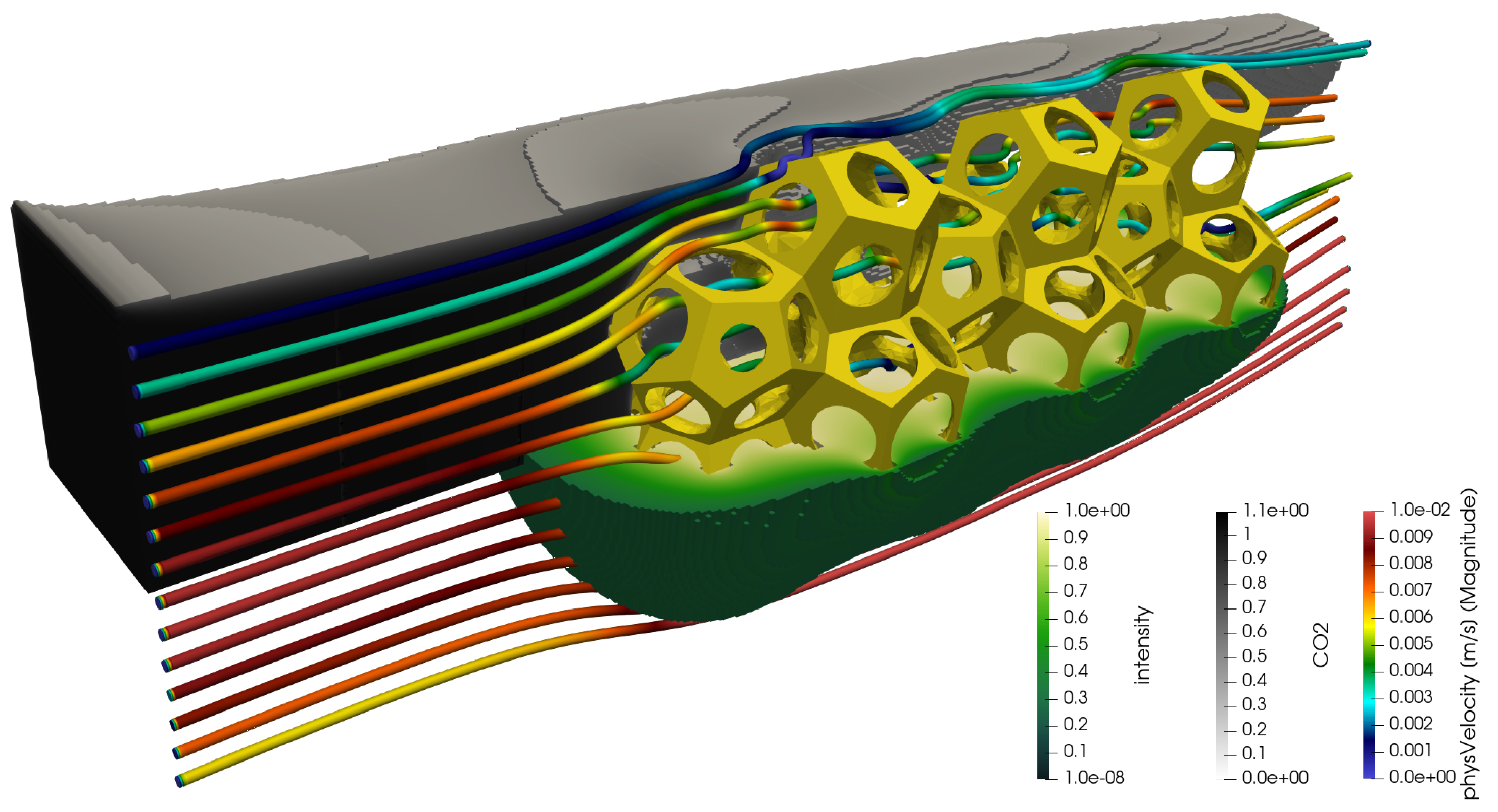
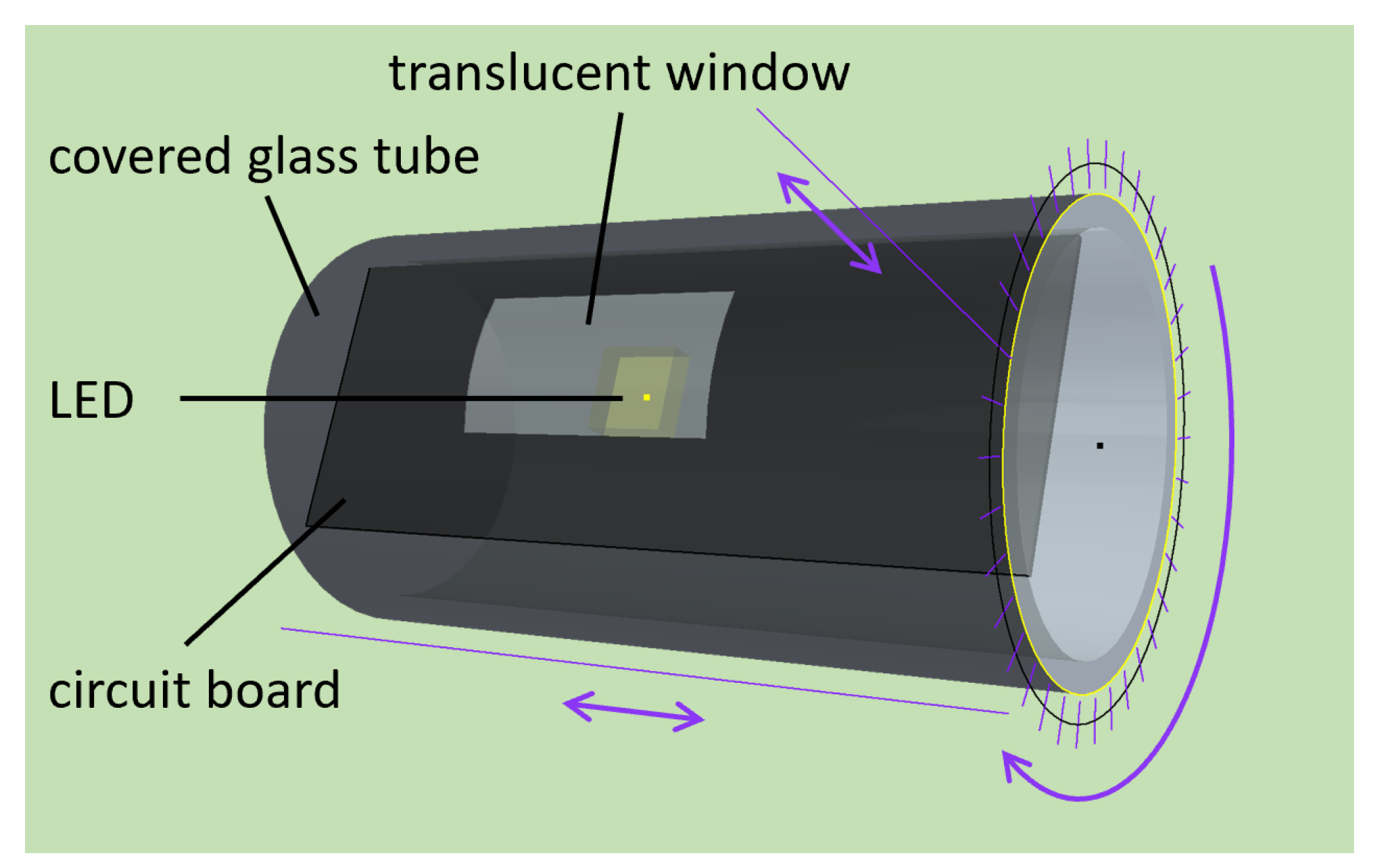
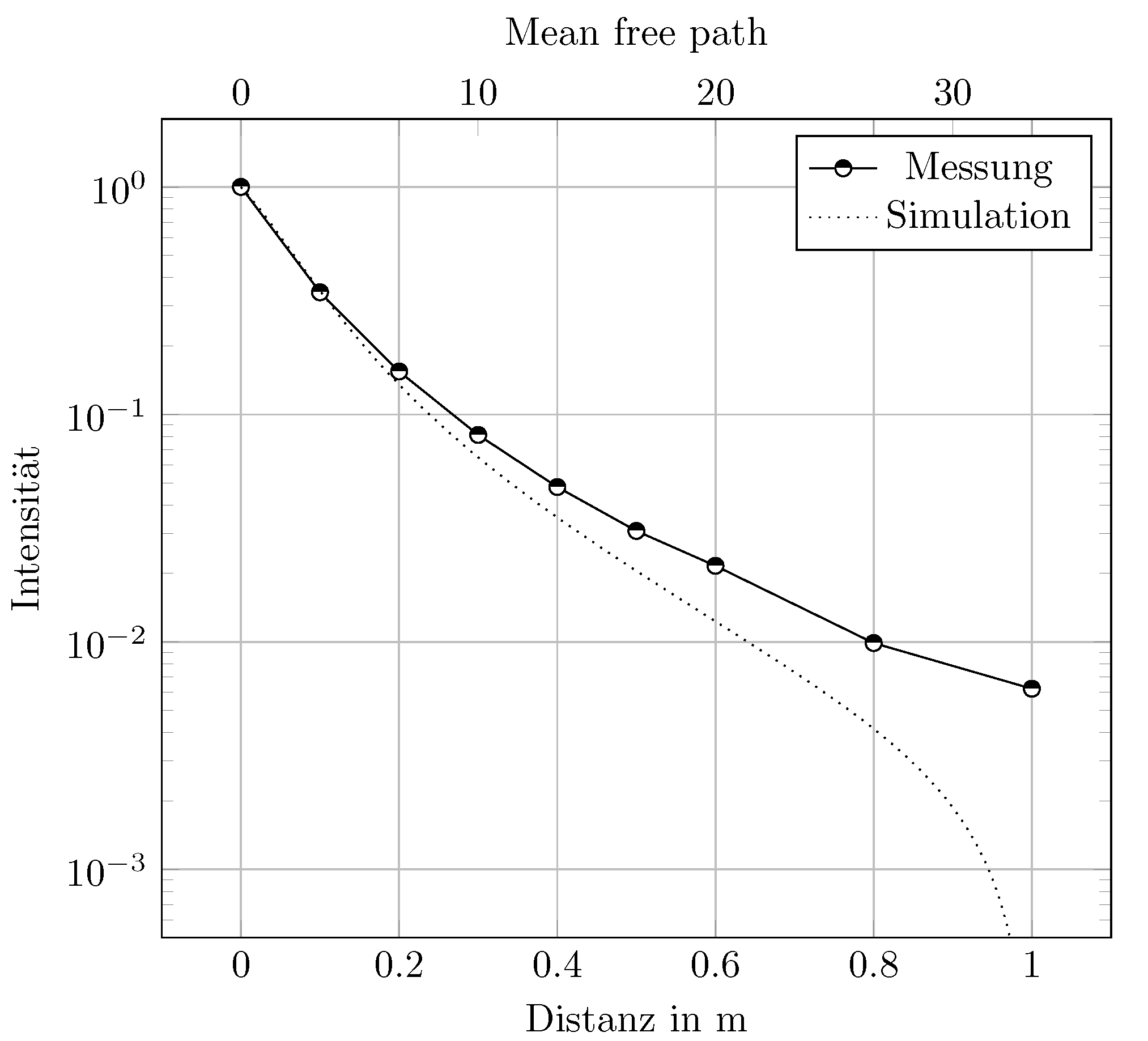


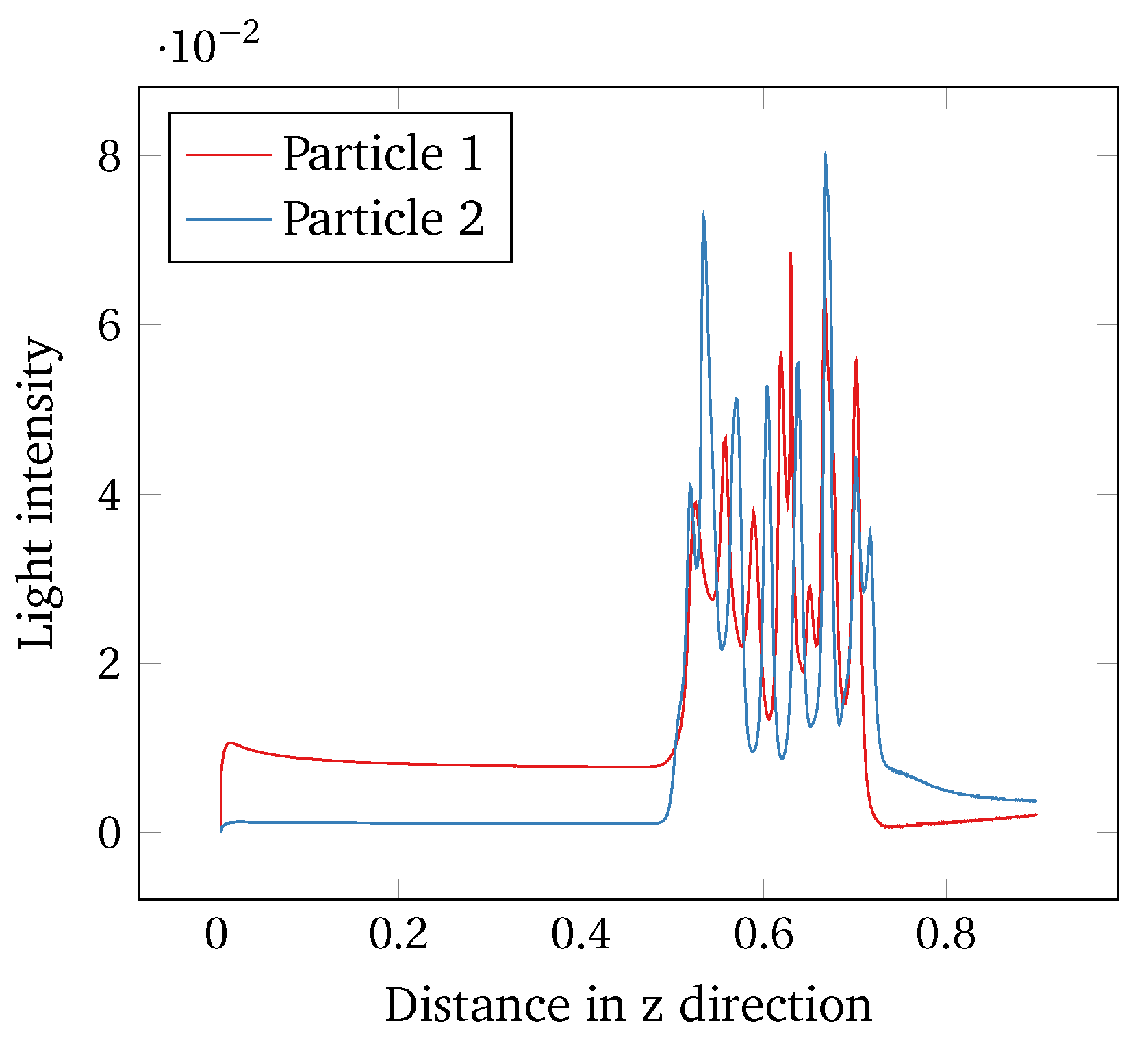
| in nm | in m/kg | in m/kg |
|---|---|---|
| 470 | 400 | 800 |
| 600 | 140 | 1700 |
| 680 | 380 | 1300 |
Publisher’s Note: MDPI stays neutral with regard to jurisdictional claims in published maps and institutional affiliations. |
© 2022 by the authors. Licensee MDPI, Basel, Switzerland. This article is an open access article distributed under the terms and conditions of the Creative Commons Attribution (CC BY) license (https://creativecommons.org/licenses/by/4.0/).
Share and Cite
Mink, A.; Schediwy, K.; Posten, C.; Nirschl, H.; Simonis, S.; Krause, M.J. Comprehensive Computational Model for Coupled Fluid Flow, Mass Transfer, and Light Supply in Tubular Photobioreactors Equipped with Glass Sponges. Energies 2022, 15, 7671. https://doi.org/10.3390/en15207671
Mink A, Schediwy K, Posten C, Nirschl H, Simonis S, Krause MJ. Comprehensive Computational Model for Coupled Fluid Flow, Mass Transfer, and Light Supply in Tubular Photobioreactors Equipped with Glass Sponges. Energies. 2022; 15(20):7671. https://doi.org/10.3390/en15207671
Chicago/Turabian StyleMink, Albert, Kira Schediwy, Clemens Posten, Hermann Nirschl, Stephan Simonis, and Mathias J. Krause. 2022. "Comprehensive Computational Model for Coupled Fluid Flow, Mass Transfer, and Light Supply in Tubular Photobioreactors Equipped with Glass Sponges" Energies 15, no. 20: 7671. https://doi.org/10.3390/en15207671
APA StyleMink, A., Schediwy, K., Posten, C., Nirschl, H., Simonis, S., & Krause, M. J. (2022). Comprehensive Computational Model for Coupled Fluid Flow, Mass Transfer, and Light Supply in Tubular Photobioreactors Equipped with Glass Sponges. Energies, 15(20), 7671. https://doi.org/10.3390/en15207671






